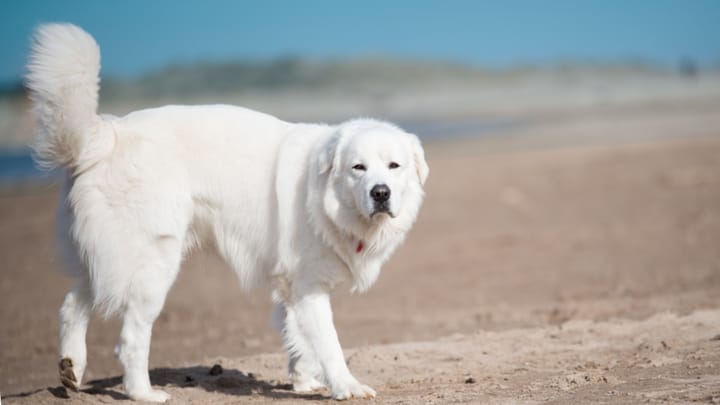Tatra Shepherd Dog
Other names : Polish Tatra Sheepdog, Tatra Mountain Sheepdog, Owczarek Tatrzański, Owczarek Podhalański, Polski Owczarek, Polish Podhale Sheepdog

The Tatra Sheepdog, more commonly known as the Polish Podhale Sheepdog, is a very strong, quiet dog, used today as a watchdog. They are very gentle with their master, but act suspicious around strangers. They have a calm temperament, are poised and balanced; and their independence makes them easy to train as long as the training methods are respectful. They are particularly fond of children and have a great protective instinct.
|
Life expectancy |
The Tatra Shepherd Dog has a life expectancy of between 10 and 14 years |
|
Temperament |
|
|
Size |
Large
|
|
Adult size |
Female
Between 24 and 26 in
Male
Between 26 and 28 in
|
|
Adult weight |
Female
Between 66 and 88 lb
Male
Between 66 and 88 lb
|
|
Coat colour
Their coats are white. |
White |
|
Type of coat
Their coats are long. Their coat is short around their head and long on their body. The hair is usually straight (although can sometimes be slightly wavy), dense and hard to the touch. Their undercoat is thick and they have a mane around their necks. |
Long |
|
Eye colour
Their eyes are dark brown. |
Brown
|
In the mountainous regions of Poland, Tatra Sheepdogs wear metal collars or studded necklaces to protect them from wolf attacks that are always aimed at the throat or neck.
More details about the Tatra Shepherd Dog
Tatra Shepherd Dog: Origins and history
Tatra Sheepdogs originated as dogs imported by Phoenician traders from the East and probably arrived in Europe via Africa. The Phoenicians used these dogs as exchange items, trading them for valuable products such as silver, glass, or cloth. The Romans also used them in wartime to watch their prisoners. They were also pet dogs for aristocrats. The World Canine Organisation officially recognised this breed in 1963.
Physical characteristics of the Tatra Shepherd Dog
The Tatra Sheepdog is a large, imposing dog, similar to Newfoundlands but they’re completely white! The head is large with a slightly arched crown and a marked stop. Their eyes are medium sized and slightly almond shaped. They come across as intelligent and they look sweet and dreamy. Their ears are at the same height as the outer corners of their eyes, are medium sized, triangular and covered in hair. Their tail is attached in the middle and goes down to the back of their knees.
FCI classification of the Tatra Shepherd Dog
-
Group 1 - Sheepdogs and Cattledogs (except Swiss Cattledogs)
-
Section 1 : Sheepdogs
Tatra Shepherd Dog: Characteristics
Tatra Shepherd Dog: Behaviour
Training a Tatra Shepherd Dog
Although it can be difficult to motivate these large dogs, they are generally docile dogs who want to please their master.
On the other hand, you should start training them as soon as they arrive home as a puppy, because given the size of them as adults, you need to learn to control them, especially in towns, or when guests arrive, for example.
Tatra Shepherd Dog: Lifestyle
Breed compatibility Tatra Shepherd Dog
Tatra Shepherd Dog: Purchase price
Polish Tatra Sheepdogs prices vary according to their origin, age and sex. We do not have enough information to be able to set an average price for this dog breed.
It will cost, on average, £50/month to meet the needs of this breed.
Tatra Shepherd Dog: Shedding
Heavy !
When moulting, this dog loses a lot of hair and daily brushing will get rid of most of the dead hair.
Tatra Shepherd Dog: Grooming
These dogs normally don’t need to be groomed, unless their white coats get particularly dirty. Bathing them twice a year should be enough to maintain a healthy coat.
Weekly brushing is sufficient to maintain their coat and their eyes and ears should be inspected and cleaned regularly.
Tatra Shepherd Dog: Health
Their life expectancy is about 12 years.
This dog does not fear much, aside from other large dogs.
Their undercoat allows them to be protected from the heat as well as the cold, however their owners must pay attention when it is particularly warm. If they live outside, make sure they have somewhere shady to rest.
Their origins and thick coats mean they can easily tolerate bad weather. They can live outdoors and are not afraid of the cold.
In general, the only members of this breed that become overweight are those who never leave their gardens. Although they’re not the most athletic, they still need some exercise to maintain a good physical and mental balance.
- Hip dysplasia
- Bloating/torsion of the stomach


